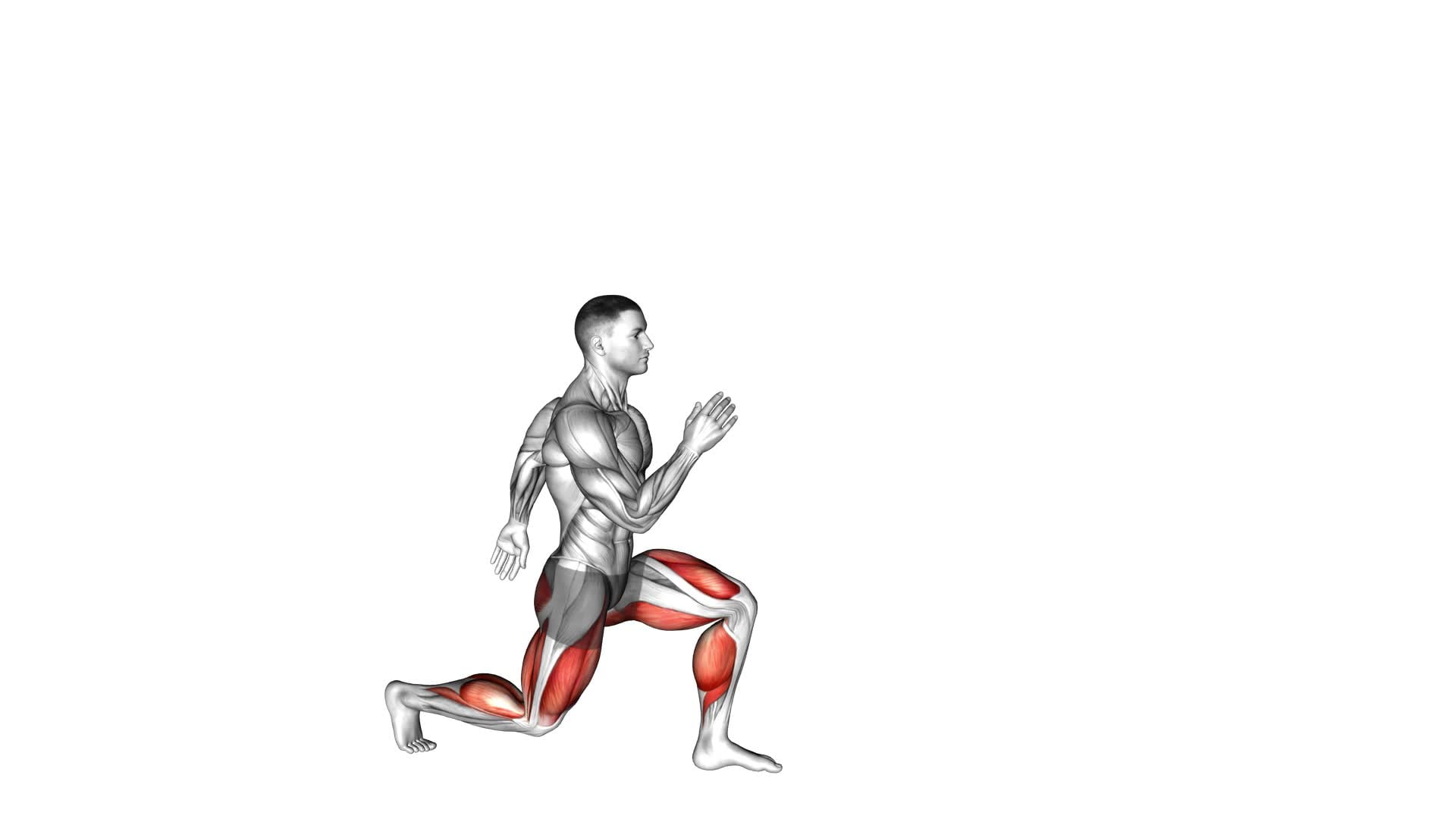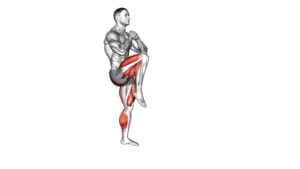Lunge With Jump – Video Exercise Guide & Tips

Are you looking to take your lunges to the next level?
Watch This Exercise Video
In this video exercise guide, we'll show you how to do the Lunge With Jump correctly and efficiently. Whether you're a beginner or a seasoned fitness enthusiast, we've got you covered with modifications for different fitness levels.
Avoid common mistakes and maximize your results with our expert tips.
Get ready to lunge and jump your way to a stronger, fitter you!
Key Takeaways
- The lunge with jump is a beneficial exercise for increasing lower body strength, explosiveness, and cardiovascular health.
- Proper form and technique are essential, including keeping the front knee directly above the ankle and landing softly with a stable stance.
- Common mistakes to avoid include poor form, incorrect landing, not generating enough power, neglecting warm-up, and failing to engage the core for stability.
- Modifications for different fitness levels include starting with a basic lunge, eliminating the jump, adding weights, increasing jump intensity, and incorporating resistance.
Benefits of the Lunge With Jump
To maximize the effectiveness of your workout, incorporate the lunge with jump for increased lower body strength and explosiveness. Plyometric lunges, also known as jumping lunges, are a dynamic exercise that combines the benefits of lunges with the explosive power of jumps. This exercise targets your quadriceps, hamstrings, glutes, and calves, providing a comprehensive lower body workout.
One of the main benefits of plyometric lunges is the cardiovascular aspect. By incorporating jumps into your lunges, you elevate your heart rate and engage your cardiovascular system. This helps improve your endurance and overall cardiovascular health. Additionally, the explosive nature of the movement increases your power and speed, making it a great exercise for athletes and those looking to improve their athletic performance.
Proper form and technique are essential when performing plyometric lunges. Start by standing with your feet shoulder-width apart. Step forward into a lunge position, making sure your front knee is directly above your ankle and your back knee is hovering just above the ground. From this position, explode upwards, switching your legs mid-air, and land softly back into the lunge position. Repeat for the desired number of reps.
Proper Form and Technique
To ensure proper form and technique when performing the lunge with jump exercise, focus on maintaining a stable stance and explosive movements. Start by standing with your feet hip-width apart and your hands on your hips. Take a big step forward with your right foot, lowering your body into a lunge position. Make sure your front knee is directly above your ankle and your back knee is hovering just above the ground. From this position, explode off the ground, switching your feet mid-air and landing softly with your left foot forward and your right foot back, sinking into another lunge. Repeat the movement for the desired number of repetitions.
When performing the lunge with jump, it's important to avoid common errors such as allowing your front knee to collapse inward or leaning too far forward. To maintain a stable stance, engage your core and keep your chest lifted throughout the exercise. Additionally, be mindful of your landing, ensuring that you land softly and absorb the impact with your muscles rather than your joints.
To make the lunge with jump exercise more challenging or to target different muscles, you can try some effective variations. One variation is to hold dumbbells in each hand, adding resistance to the exercise. Another variation is to perform the exercise on an unstable surface, such as a balance board or a BOSU ball, to further engage your core and challenge your balance. Remember to always start with proper form and technique and gradually progress to more advanced variations as your strength and stability improve.
Modifications for Different Fitness Levels
Whether you're a beginner or advanced, there are modifications available to cater to different fitness levels when performing the lunge with jump exercise. For beginners, it's important to start with the basic lunge before progressing to the jump. Begin by standing with your feet hip-width apart and take a step forward with one foot, lowering your body into a lunge position. To modify, you can eliminate the jump and simply return to the starting position after completing the lunge. This reduces the impact on your joints and allows you to focus on building strength and stability.
Advanced modifications for the lunge with jump include adding weights or increasing the intensity of the jump. You can hold dumbbells or kettlebells in your hands to add resistance and challenge your muscles even more. Additionally, you can increase the height and explosiveness of the jump by jumping higher or incorporating plyometric variations, such as tuck jumps or split jumps. These modifications will help to further enhance your strength, power, and overall athletic performance.
Common Mistakes to Avoid
When performing the lunge with jump exercise, it's important to be aware of common mistakes that can hinder your progress and increase the risk of injury. Here are some tips for improvement:
- Poor form: One of the most common mistakes isn't maintaining proper form throughout the exercise. Avoid leaning forward, rounding your back, or letting your knees cave in. Keep your chest up, shoulders back, and engage your core for stability.
- Landing incorrectly: Another mistake is landing with your knees locked or too close together. This puts unnecessary stress on your joints and increases the risk of injury. Instead, focus on landing softly with your knees bent and tracking over your toes.
- Not using enough power: To get the most out of the lunge with jump, you need to generate power from your legs and glutes. Make sure you're pushing off with force and using a full range of motion in both the lunge and the jump.
- Neglecting proper warm-up: Skipping a proper warm-up can lead to muscle imbalances and increase the risk of injury. Before starting the exercise, warm up your muscles with dynamic stretches and exercises that target the lower body.
Tips for Maximizing Results
To achieve the best results from the lunge with jump exercise, it's important that you focus on proper technique and intensity. By maximizing efficiency and incorporating variations, you can take your workout to the next level.
Firstly, to maximize efficiency, ensure that you're performing the exercise with correct form. Start by standing with your feet shoulder-width apart and take a step forward into a lunge position. As you lower your body into the lunge, make sure your front knee is directly above your ankle and your back knee hovers just above the ground. When you jump, explode off the ground using both legs and switch your position in mid-air, landing in the opposite lunge. This continuous movement will help you engage more muscles and burn more calories.
In addition to proper technique, incorporating variations can further enhance your results. Try adding weights by holding dumbbells in each hand or wearing ankle weights. This will increase the resistance and challenge your muscles even more. Another variation is the lateral lunge with jump, where instead of stepping forward, you step to the side into a lunge and then jump laterally to switch sides.
Frequently Asked Questions
How Many Calories Can You Burn by Doing Lunge With Jump Exercises?
You can burn a significant amount of calories by doing lunge with jump exercises. The intensity and duration of these exercises play a key role in calorie burn.
Compared to other high-intensity exercises, lunge with jump exercises can be equally effective in burning calories. The explosive movement involved in this exercise engages multiple muscle groups, boosting your metabolism and increasing calorie burn.
Incorporating lunge with jump exercises into your routine can help you achieve your calorie-burning goals.
Can Lunge With Jump Exercises Help Improve Balance and Coordination?
Lunge with jump exercises can improve your balance and coordination. By incorporating explosive movements and requiring you to stabilize your body, these exercises challenge your muscles and enhance your ability to control your movements.
The benefits of lunge with jump exercises extend beyond just strength training. They also help to increase your agility and power.
Additionally, there are various variations of lunge with jump exercises that you can try to target different muscle groups and keep your workouts interesting.
Are There Any Specific Breathing Techniques to Follow While Performing Lunge With Jump Exercises?
When performing lunge with jump exercises, it's important to focus on your breathing techniques. By inhaling deeply through your nose and exhaling forcefully through your mouth, you can engage your core and increase your stability. This rhythmic breathing pattern can help you maintain control and power during the exercise.
Additionally, if you need to modify the exercise due to any limitations or injuries, you can always perform a modified version that suits your needs.
Can Lunge With Jump Exercises Help Strengthen the Core Muscles?
Lunge with jump exercises can be beneficial for strengthening your core muscles. By incorporating explosive movements into your lunges, you engage your abdominal muscles and challenge your stability.
The variations of lunge with jump exercises, such as plyometric lunges or jump lunges, require core activation to maintain proper form and balance. These exercises not only target your lower body but also help develop a stronger and more stable core.
Is It Safe to Perform Lunge With Jump Exercises if You Have Knee or Ankle Injuries?
If you have knee or ankle injuries, it's important to consider your safety when performing lunge with jump exercises. These exercises can put extra strain on your joints and may worsen your injuries.
Instead, try modifying the lunge or exploring alternative exercises that are less impactful on your knees and ankles.
It's always best to consult with a qualified fitness professional or healthcare provider for personalized guidance and recommendations.
Conclusion
Incorporating the lunge with jump into your workout routine can offer numerous benefits. This exercise is great for improving lower body strength, cardiovascular endurance, and explosiveness. By following proper form and technique, you can maximize the effectiveness of this exercise. Remember to modify the movement according to your fitness level and avoid common mistakes like incorrect landing or excessive forward lean. With these tips, you'll be on your way to achieving great results with the lunge with jump.

Author
Years ago, the spark of my life’s passion ignited in my mind the moment I stepped into the local gym for the first time. The inaugural bead of perspiration, the initial endeavor, the very first surge of endorphins, and a sense of pride that washed over me post-workout marked the beginning of my deep-seated interest in strength sports, fitness, and sports nutrition. This very curiosity blossomed rapidly into a profound fascination, propelling me to earn a Master’s degree in Physical Education from the Academy of Physical Education in Krakow, followed by a Sports Manager diploma from the Jagiellonian University. My journey of growth led me to gain more specialized qualifications, such as being a certified personal trainer with a focus on sports dietetics, a lifeguard, and an instructor for wellness and corrective gymnastics. Theoretical knowledge paired seamlessly with practical experience, reinforcing my belief that the transformation of individuals under my guidance was also a reflection of my personal growth. This belief holds true even today. Each day, I strive to push the boundaries and explore new realms. These realms gently elevate me to greater heights. The unique combination of passion for my field and the continuous quest for growth fuels my drive to break new ground.







